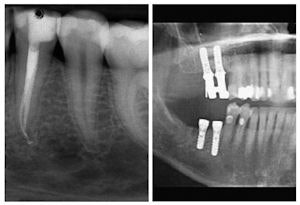
The debate over how best to care for diseased teeth heated up last week when the American Academy of Implant Dentistry (AAID) issued a press release asserting that implants are more reliable than root canals.
The statement drew an immediate rebuttal from the American Association of Endodontists (AAE), which in November issued its own press release suggesting the opposite.
"In most cases, implants deliver the best results, as the ultimate goal is to achieve an aesthetic and functional restoration for years to come," said AAID spokesman John Minichetti, D.D.S., of Englewood, NJ, in the press release.
 |
|
The American Academy of Implant Dentistry and the American Association of Endodontists disagree about whether implants are superior to endodontics. Image courtesy of the AAE. |
The AAID goes on to claim that "published studies have shown there is a higher failure rate of root canal procedures vs. dental implants."
A "recent" study published in the Journal of Oral Implantology found that "single-tooth dental implants are 98.5 percent successful after seven years and there was no discernable bone loss in almost all the implant sites," according to the AAID.
By comparison, "first-time root canals fail 5 percent of the time, according to the American Academy of General Dentistry (AGD), and at much higher rates in repeat procedures," the AAID stated. "Further, endodontic surgical retreatments, according to published studies, have success rates ranging from 37 to 87 percent."
But James Kulild, D.D.S., M.S., secretary of the AAE, said research has not shown either implants or endodontics to be superior. "If you look at quality systematic reviews, you will find that the success rates are very similar," he said.
Consensus statement
An AAE staff person provided a consensus statement produced by a multidisciplinary panel of the Academy of Osseointegration and published in 2007 in the International Journal of Oral and Maxillofacial Implants (Vol. 22:Suppl., pp. 96-116). The panel approved a review, finding "no significant differences in survival between restored root canal-treated teeth and single-tooth implants."
The AAE also provided a copy of the AGD Impact (August 2007, Vol. 35:8, pp. 18-19) in which AGD spokesman Neil Gajjar, D.D.S., is quoted as saying, "it is true that studies show equal survival rates of single tooth implants and endodontically restored teeth."
Louis Rossman, D.M.D., immediate past president of the AAE, also questioned the AAID's claim that survival rates of retreated teeth are as low as 37%. "If I'm going to retreat a tooth, it's going to be in the high 80s or 90s," he said.
Dr. Kulild, a University of Missouri-Kansas City School of Dentistry professor who does root canals and also places implants, said he did agree with some of the statements in the AAID press release. "Implants are a wonderful adjunct to dentistry today," he said. "One of the effects it's had on endodontists is that we don't do as many heroic procedures as we have in the past."
For example, as the AAID pointed out, endodontists sometimes used to expose a root in the aesthetic zone to attach a crown. Nowadays, it's usually better to place an implant in such circumstances, he said.
On the other hand, both types of treatment can result in aesthetic failures, Dr Kulild noted. And once you extract a tooth, "there's no plan B," he said. "Once you lose a tooth, you can't grow another one."
The AAE is ready and willing to cooperate with other specialty groups, including the AAID, Dr. Kulild said. Dr. Rossman said the AAE participates in a joint semiannual meeting that includes other specialists who place implants (though he noted that implant dentistry is not recognized as a specialty by the ADA).
"Everyone's fighting for their own turf," Dr. Rossman said. "Everyone is panicked that someone is going to take over. But everyone should be working together."
Calls to Dr. Minichetti and the AAID press office for comment were not returned.
Copyright © 2009 DrBicuspid.com



















